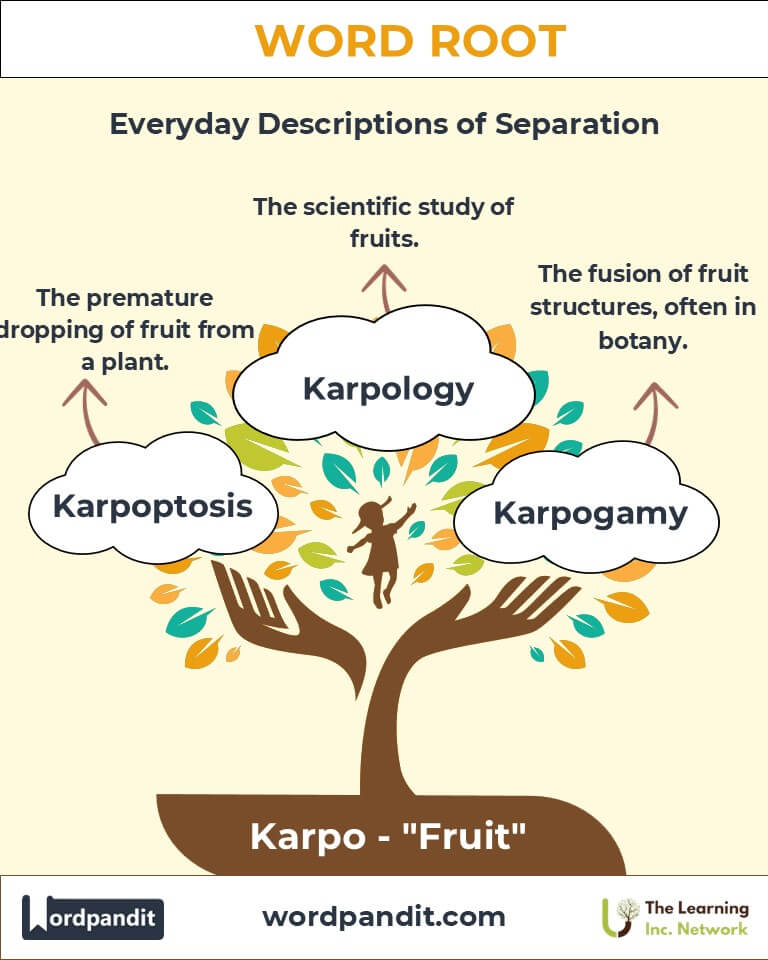Karpo: The Fruitful Root of Growth and Yield
Discover the profound impact of the root "karpo," originating from Greek and meaning "fruit." From the scientific study of fruits in "karpology" to the union of fruits in "karpogamy," this root branches out into fields like botany, agriculture, and mythology, symbolizing growth, productivity, and natural cycles.

1. Introduction: The Essence of "Karpo"
Imagine a tree laden with ripe fruits, symbolizing abundance and the cycle of life. The root "karpo" (pronounced kar-poh), derived from the Greek word for "fruit," embodies this imagery. It serves as the foundation for terms in botany, agriculture, and beyond, connecting us to the idea of fruition, productivity, and natural progression.

2. Etymology and Historical Journey
The root "karpo" traces back to Ancient Greek καρπός (karpos), meaning "fruit" or "yield." In early Greek culture, it symbolized not just physical fruit but also metaphorical fruition—harvests of effort and time. Over centuries, "karpo" gave rise to terms in science and art, preserving its essence of abundance and growth.
3. Mnemonic: Unlocking the Power of "Karpo"
To remember "karpo," picture a fruitful orchard teeming with life. The imagery of fruits and their connection to productivity helps anchor the meaning.
4. Common "Karpo"-Related Terms
- Karpology (kar-pah-luh-jee): The scientific study of fruits.
Example: "The karpology professor explained the unique seed dispersal mechanisms in tropical fruits." - Karpogamy (kar-poh-guh-mee): The fusion of fruit structures, often in botany.
Example: "Karpogamy ensures the development of complex fruit forms in certain plant species." - Carpophore (kar-puh-fohr): A stalk that supports a fruiting body in fungi.
Example: "The carpophore of the mushroom was examined under a microscope." - Endocarp (en-doh-karp): The innermost layer of a fruit, often enclosing the seed.
Example: "The endocarp of a peach is its hard, woody pit." - Exocarp (ek-soh-karp): The outer layer of a fruit.
Example: "The exocarp of citrus fruits is commonly used in zesting."
5. "Karpo" Through Time
- Ancient Roots: Early agricultural texts in Ancient Greece used "karpo" to describe crop yields and harvest festivals.
- Scientific Advances: During the Enlightenment, "karpo" entered scientific nomenclature with the rise of botany as a formal discipline.
6. "Karpo" in Specialized Fields
- Botany:
- Term: Karpology
- Relevance: Studies fruit formation and development.
- Agriculture:
- Term: Karpogamy
- Application: Facilitates the creation of fruit-bearing plants with improved traits.
- Mycology:
- Term: Carpophore
- Significance: Critical in fungal identification and ecology.
7. Illustrative Story: "Karpo" in Action
Dr. Elena Morales, a renowned karpologist, dedicated her life to studying tropical fruits. One day, she discovered a rare plant capable of karpogamy, producing unique hybrid fruits. Her work not only advanced the science of karpology but also contributed to sustainable agricultural practices, reducing food insecurity in local communities.
8. Cultural Significance of the "Karpo" Root
In mythology, "karpo" is associated with Carpo, one of the Greek Horae, who governed the harvest season. The root symbolizes prosperity and the rewards of labor, often celebrated in harvest festivals worldwide.

9. The "Karpo" Family Tree
- Phyto- (Greek: plant):
- Phytology: Study of plants.
- Phytoplankton: Microscopic plant-like organisms in water.
- Fru- (Latin: fruit):
- Fructify: To make fruitful.
- Fructose: A natural sugar found in fruits.
- Seed- (Old English):
- Seedling: A young plant.
- Seedbed: A prepared area for planting seeds.
10.FAQs About the Karpo Word Root
Q: What does "karpo" mean?
A: "Karpo" is a Greek root meaning "fruit." It symbolizes both physical fruits and the concept of productivity and fruition, forming the basis for many botanical and scientific terms.
Q: What is karpology?
A: Karpology is the scientific study of fruits, examining their structures, development, and classification. It provides insights into plant reproduction and seed dispersal mechanisms.
Q: How does "karpogamy" differ from "pollination"?
A: Pollination refers to the transfer of pollen between male and female reproductive parts of a plant. Karpogamy, on the other hand, involves the fusion of fruit structures during development, occurring after fertilization.
Q: What is a carpophore?
A: A carpophore is a stalk-like structure that supports the fruiting body in fungi or parts of a compound fruit. For instance, in parsley fruits, the carpophore splits to support each half of the fruit.
Q: What is the difference between "endocarp" and "exocarp"?
A: The endocarp is the innermost layer of a fruit, often hard and protective, like the pit of a peach. The exocarp, in contrast, is the outermost layer, such as the skin or rind of a fruit.
11.Test Your Knowledge: Karpo Word Root Quiz
1. What does "karpo" mean?
2. What is karpology?
3. What does karpogamy involve?
4. Which term describes the innermost layer of a fruit?
5. Which field focuses on plant reproductive structures?

12. Conclusion: The Living Legacy of "Karpo"
The root "karpo" reminds us of nature's bounty and the intricate systems that sustain life. From ancient harvests to modern agricultural advancements, "karpo" continues to inspire growth, productivity, and interconnectedness. As we explore new frontiers in science and sustainability, the legacy of "karpo" ensures that the fruits of our labor endure. 🌿











